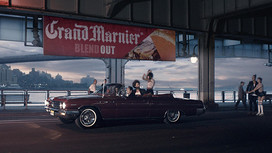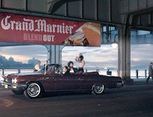New technology - early warning:
Product placements in music videos
New technologies open up for inserting product placements in movies after a film has been produced. Alcohol companies are among the first to test the new technology. More alcohol marketing globally, and also more hidden and sophisticated marketing, may be the result.
Product placements in films, music videos, songs etc. is a well-known marketing technique, with James Bond’s Martinis and Volvo T1800 as an early start in the late 1950s. Today product placement is a widely used strategy for marketers of many consumer products, and also a technique on the increase. MirriAd and Universal Music Group have now developed a technology that makes it possible to insert, or superimpose, advertisements and products after a media product has been made, reports Financial Times in their online edition on the 29th of September.

As the picture shows, alcohol producers are at the forefront in testing the new possibilities. Financial Times reports that one of the first results of the deal between Universal and MirriAd will be to insert Grand Marnier, the liqueur brand, into a video by Avicii, the Swedish dance music producer. Furthermore, once the Grand Marnier campaign is finished, Universal will be able to open up the video to other brands – something that was impossible with traditional product placement techniques.
Having an advertisement inside the content is considered more valuable by marketers than having an ad outside a film, a TV show, a song or a music video. More so as consumers tend to skip or ignore advertisements when they appear in commercial breaks during or before a programme. If an ad is placed within the movie you see or in the middle of a song you listen to you have no choice as a consumer.
More flexible
The most interesting feature of the new technology is that you don’t have to plan where and how products shall appear before you shoot a film or a music video. This makes the production more flexible as it allows a billboard along a road or in a city scene to be inserted after the scene has been shot on a location where there were no such advertisements. Or you can insert certain bottles or alcohol brands in a scene from a bar, a restaurant or in a private home. Advertisers can now be presented with a list of suggestions as to where their product or their ad can be placed in a film which is already produced.
The new technology is also more flexible in the sense that product placements can be targeted towards different groups of viewers, for instance that viewers in one country can see ads or products which are different from what they see in a neighbouring country.
Global impact, also in developing societies
Innovations like this can be expected to have global impact, since popular Western movies, music videos or songs normally appear in almost all countries in the world, low or middle income countries in the global South being no exception.
Financial Times quotes PQ Media, a research group, which have estimated that USD 8.25 billion was spent on product placements worldwide in 2012. Most of this is used for placing products in films and TV shows, but an increasing portion of the money is now being used towards the music industry and the game industry. Since the sale of recorded music has halved in the last decade, advertising, product placements and sponsorships have become increasingly important sources of income for music companies and artists alike.
Hip-hop artists
In particular hip-hop artists have been eager to connect themselves to consumer products and to promote these products in their lyrics. Some years ago a special web site was constructed in the US to count how many times products were mentioned and promoted by individual music artists. In a single week the web site counted that on the Billboard singles chart there were six songs in the top 20 with one or more product references.
Lucien James, a spokesperson of this web site - “Americanbrandstand”- pointed to the hip-hop artist Busta Rhymes’ smash hit “Pass the Courvoisier” as an example of a product endorsement that changed the way deals are done. Busta’s management has said that his massive hit about the cognac brand was merely an artistic choice. Maybe so, but it also helped Courvoisier’s producers Domecq achieve a double-digit increase in U.S. sales of their liquor. The producer later reached a promotional deal with Busta’s management company, Violator.
RELATED ARTICLES
- Victory for the constitutional right to be consulted on alcohol trading within communities
- Monitoring Alcohol Marketing
- Current controls on alcohol marketing are not protecting youth, warn public health experts
- Alcohol marketing in Africa violates industry’s own marketing codes
- Powerful reminders of the many real effects of alcohol consumption

